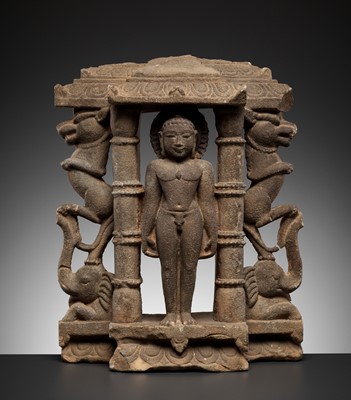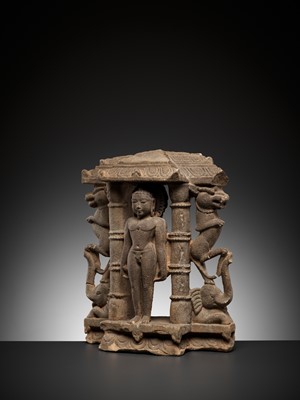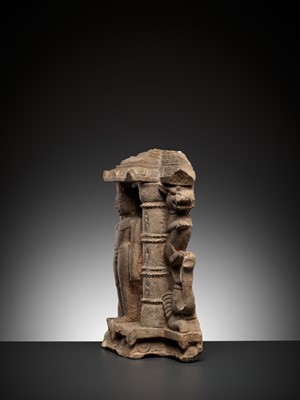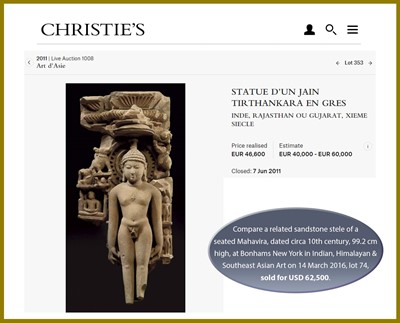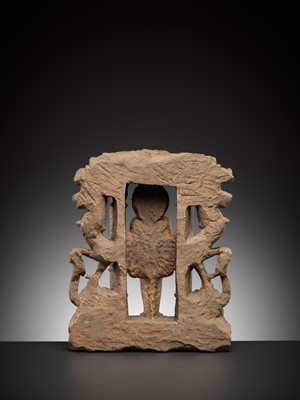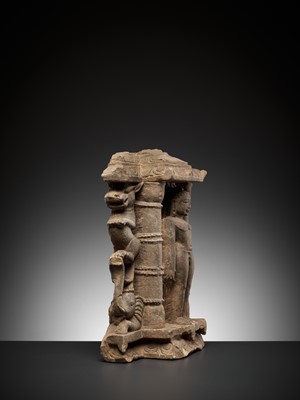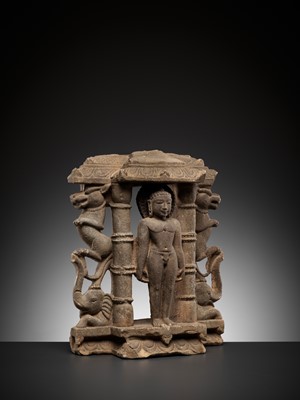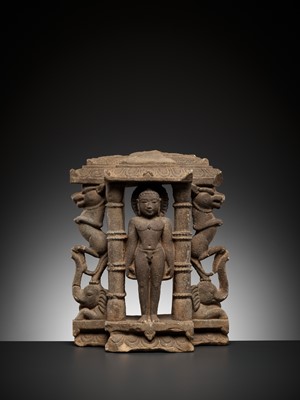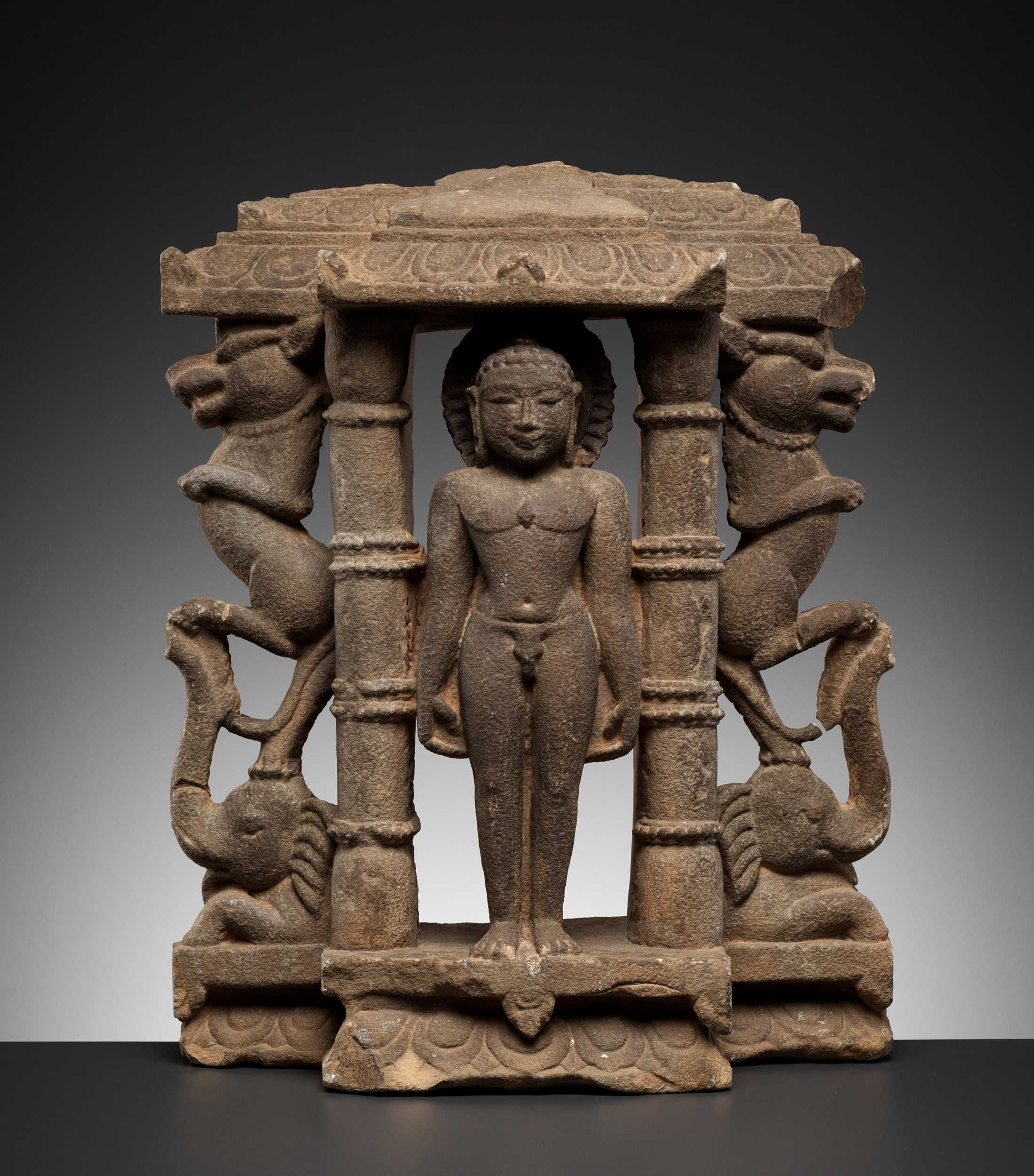11th Mar, 2022 10:00
DAY 2 - TWO-DAY AUCTION - Fine Chinese Art / 中國藝術集珍 / Buddhism & Hinduism
598
A JAIN SANDSTONE STELE OF A TIRTHANKARA, POSSIBLY MAHAVIRA
Sold for €8,216
including Buyer's Premium
Central or Northern India, 12th-13th century. Finely carved in openwork with the central tirthankara standing between two pillars atop a square base and below a stepped roof, both carved with stylized lotus petals, a halo behind his head, the serene face with heavy-lidded eyes, broad nose, full lips, and elongated earlobes, the hair in tight curls. The deity is flanked by a vyala standing on a recumbent elephant’s head to either side.
Provenance: From a noted Belgian private collection.
Condition: Excellent condition, commensurate with age. Extensive wear, minor losses, nicks and scratches, signs of weathering and erosion, structural cracks, encrustations.
Dimensions: Height 43 cm
Jinas are depicted in only two poses: kayostarga, standing, or dhyani, seated in meditation, and due to the identical poses and expressions they are distinguished mainly by their vahanas, or vehicles, appearing at the feet of the figures or carved on to the pedestals. In the present example, the pedestal is missing and therefore an exact identification of the Jina is not possible. However, Mahavira is the most commonly represented of the Tirthankaras in the kayostarga attitude, and for this reason an attribution seems appropriate.
The earliest extant Jain images date to the first century C.E. and were created in the area around Mathura, the center of much religious activity. Jainism is India’s third great ancient religion and was founded contemporaneously with Buddhism from which it differed by its advocating the attainment of a spiritual life through asceticism. This may account for the conventional depiction of Tirthankaras in a rigid frontal pose. The term Jina, meaning “Conqueror” or “Victor of over Life” is applied to one who, like the Buddha, has attained perfect knowledge. Tirthankara meaning “He who has crossed the Ford” of rebirth and attained perfect freedom, is equivalent to Jina. In many respects, and more particularly in the seated poses, the Jina figure has many parallels to the Buddha image with the exception that, among the Digambara sect of Jains, the figure is always nude and the chest bears the srivasta.
The nudity of Jain saints was a practice of both asceticism and their belief in non-possession, dating back to the days of Mahavira. However a schism arose in around 79 C.E., extensively recorded in their literature, about what constitutes total renunciation. At the time Jain monks separated into rival factions, the Digambaras “clothed with the sky” or nude and the Svetambaras, “clothed with white”, who partially clad themselves with white cloth. According to inscriptions the Svetambaras worshipped the nude image without objection and for both sects the Jinas and the saint Bahubali are represented naked while all other deities are clothed and even ornamented.
This sculpture not only possibly represents Mahavira but more, it symbolizes man disregarding the material world and his animal nature. The figure is a human being transformed into a god-like state and the worship of it is not a two-way interaction but a meditation, where the deity is not expected to grant favors but rather to exemplify a state of being attainable by all.
Auction result comparison: Compare a related sandstone stele of a seated Mahavira, dated circa 10th century, 99.2 cm high, at Bonhams New York in Indian, Himalayan & Southeast Asian Art on 14 March 2016, lot 74, sold for USD 62,500.
Central or Northern India, 12th-13th century. Finely carved in openwork with the central tirthankara standing between two pillars atop a square base and below a stepped roof, both carved with stylized lotus petals, a halo behind his head, the serene face with heavy-lidded eyes, broad nose, full lips, and elongated earlobes, the hair in tight curls. The deity is flanked by a vyala standing on a recumbent elephant’s head to either side.
Provenance: From a noted Belgian private collection.
Condition: Excellent condition, commensurate with age. Extensive wear, minor losses, nicks and scratches, signs of weathering and erosion, structural cracks, encrustations.
Dimensions: Height 43 cm
Jinas are depicted in only two poses: kayostarga, standing, or dhyani, seated in meditation, and due to the identical poses and expressions they are distinguished mainly by their vahanas, or vehicles, appearing at the feet of the figures or carved on to the pedestals. In the present example, the pedestal is missing and therefore an exact identification of the Jina is not possible. However, Mahavira is the most commonly represented of the Tirthankaras in the kayostarga attitude, and for this reason an attribution seems appropriate.
The earliest extant Jain images date to the first century C.E. and were created in the area around Mathura, the center of much religious activity. Jainism is India’s third great ancient religion and was founded contemporaneously with Buddhism from which it differed by its advocating the attainment of a spiritual life through asceticism. This may account for the conventional depiction of Tirthankaras in a rigid frontal pose. The term Jina, meaning “Conqueror” or “Victor of over Life” is applied to one who, like the Buddha, has attained perfect knowledge. Tirthankara meaning “He who has crossed the Ford” of rebirth and attained perfect freedom, is equivalent to Jina. In many respects, and more particularly in the seated poses, the Jina figure has many parallels to the Buddha image with the exception that, among the Digambara sect of Jains, the figure is always nude and the chest bears the srivasta.
The nudity of Jain saints was a practice of both asceticism and their belief in non-possession, dating back to the days of Mahavira. However a schism arose in around 79 C.E., extensively recorded in their literature, about what constitutes total renunciation. At the time Jain monks separated into rival factions, the Digambaras “clothed with the sky” or nude and the Svetambaras, “clothed with white”, who partially clad themselves with white cloth. According to inscriptions the Svetambaras worshipped the nude image without objection and for both sects the Jinas and the saint Bahubali are represented naked while all other deities are clothed and even ornamented.
This sculpture not only possibly represents Mahavira but more, it symbolizes man disregarding the material world and his animal nature. The figure is a human being transformed into a god-like state and the worship of it is not a two-way interaction but a meditation, where the deity is not expected to grant favors but rather to exemplify a state of being attainable by all.
Auction result comparison: Compare a related sandstone stele of a seated Mahavira, dated circa 10th century, 99.2 cm high, at Bonhams New York in Indian, Himalayan & Southeast Asian Art on 14 March 2016, lot 74, sold for USD 62,500.
Zacke Live Online Bidding
Our online bidding platform makes it easier than ever to bid in our auctions! When you bid through our website, you can take advantage of our premium buyer's terms without incurring any additional online bidding surcharges.
To bid live online, you'll need to create an online account. Once your account is created and your identity is verified, you can register to bid in an auction up to 12 hours before the auction begins.
Intended Spend and Bid Limits
When you register to bid in an online auction, you will need to share your intended maximum spending budget for the auction. We will then review your intended spend and set a bid limit for you. Once you have pre-registered for a live online auction, you can see your intended spend and bid limit by going to 'Account Settings' and clicking on 'Live Bidding Registrations'.
Your bid limit will be the maximum amount you can bid during the auction. Your bid limit is for the hammer price and is not affected by the buyer’s premium and VAT. For example, if you have a bid limit of €1,000 and place two winning bids for €300 and €200, then you will only be able to bid €500 for the rest of the auction. If you try to place a bid that is higher than €500, you will not be able to do so.
Online Absentee and Telephone Bids
You can now leave absentee and telephone bids on our website!
Absentee Bidding
Once you've created an account and your identity is verified, you can leave your absentee bid directly on the lot page. We will contact you when your bids have been confirmed.
Telephone Bidding
Once you've created an account and your identity is verified, you can leave telephone bids online. We will contact you when your bids have been confirmed.
Classic Absentee and Telephone Bidding Form
You can still submit absentee and telephone bids by email or fax if you prefer. Simply fill out the Absentee Bidding/Telephone bidding form and return it to us by email at office@zacke.at or by fax at +43 (1) 532 04 52 20. You can download the PDF from our Upcoming Auctions page.
How-To Guides
How to Create Your Personal Zacke Account
How to Register to Bid on Zacke Live
How to Leave Absentee Bids Online
How to Leave Telephone Bids Online
中文版本的操作指南
创建新账号
注册Zacke Live在线直播竞拍(免平台费)
缺席投标和电话投标
Third-Party Bidding
We partner with best-in-class third-party partners to make it easy for you to bid online in the channel of your choice. Please note that if you bid with one of our third-party online partners, then there will be a live bidding surcharge on top of your final purchase price. You can find all of our fees here. Here's a full list of our third-party partners:
- 51 Bid Live
- EpaiLive
- ArtFoxLive
- Invaluable
- LiveAuctioneers
- the-saleroom
- lot-tissimo
- Drouot
Please note that we place different auctions on different platforms. For example, in general, we only place Chinese art auctions on 51 Bid Live.
Bidding in Person
You must register to bid in person and will be assigned a paddle at the auction. Please contact us at office@zacke.at or +43 (1) 532 04 52 for the latest local health and safety guidelines.
